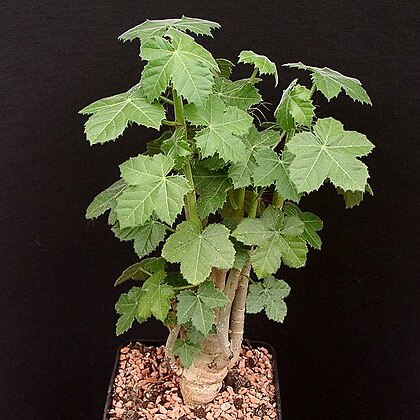Male flowers shortly pedicellate to subsessile; calyx tube 1.5 mm long; calyx lobes 1.5–2 × 1 mm, lanceolate, obtuse, entire or subentire; petals 5 × 2.5 mm, obovate, rounded, with a small patch of pubescence within at the base, otherwise glabrous, yellow; disk glands 5, free, c. 0.5 mm high, erect, turbinate, truncate; stamens 8, the 5 outer 4 mm long and fused for two-thirds their length, the 3 inner 5 mm long and fused for c. four fifths their length, filaments glabrous, anthers 1 mm long, red.
Leaf blades up to 10 × 14 cm (in Flora Zambesiaca area), 5–7-palmatipartite to palmatisect, truncate to wide-cordate at the base, acute to subacute or obtuse at lobe apices, glandular-serrate on margins, deep green; the median lobe up to 9.5 × 2.5 cm, elliptic-lanceolate, constricted at the base, the lateral lobes progressively smaller, the outermost linear-lanceolate and not basally constricted; lateral nerves in up to c. 25 pairs in the median lobe, fewer in the lateral lobes.
Female flowers: pedicels 2 mm long; calyx tube c. 0.5 mm, lobes 2.5–3 × 1 mm, extending a little in fruit, linear-lanceolate, obtuse, entire or almost so; petals 6 × 2.25 mm, elliptic, obtuse, sometimes mucronulate, completely glabrous, greenish-yellow; disk 5-lobed, the lobes semicircular, thin, flat, pink-tinged; ovary 2 × 1.5 mm, 3-lobed-ellipsoid, smooth, glabrous; styles 2.5 mm long, united for one-quarter their length, erect, stigmas small, capitate, bifid, verruculose.
Inflorescences up to 11 cm long (in Flora Zambesiaca area), terminal, laxly subcorymbiform, cymose but with the ultimate branches pseudospicate at maturity; peduncle up to 4.5 cm long; bracts up to 7 mm long, linear-lanceolate, acute, sparingly glandular-denticulate.
Seeds 9–10 × 4–5 × 3–3.5 mm, ellipsoid-cylindric, slightly shiny, greyish-brown; caruncle 2–2.5 × 3.5–4.5 mm, hemispherical, 2–many-lobed, the lobes deeply fimbriate, dark brown with a creamy-buff fringe when dried.
Softly woody herb or subshrub, up to 2 m high. Leaves usually deeply 3-5(-7)-lobed, lobes unevenly serrate. Stipules herbaceous. Fruit septici-dally dehiscent. Flowers creamy brown.
Fruits 10–12 × 8–9 mm, 3-lobed-subcylindric, smooth, glabrous, pale green; columella 7 mm long.
Stipules up to 1 cm long, multifid; the segments filiform-setaceous, gland-tipped.
A brittle-stemmed, semi-succulent, glabrous shrub up to 1.25 m tall.
Petioles up to 7.5 cm long.

